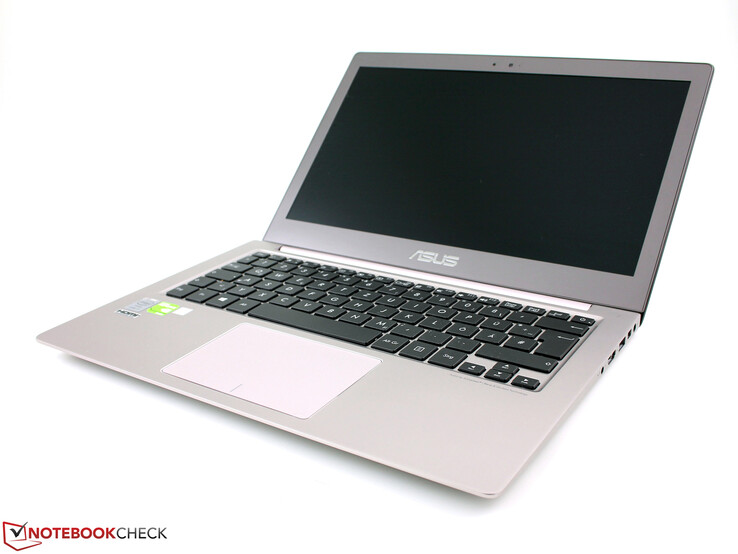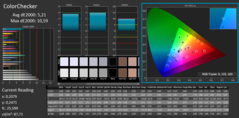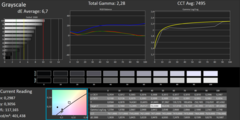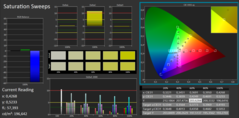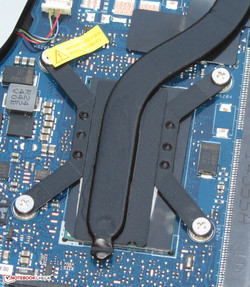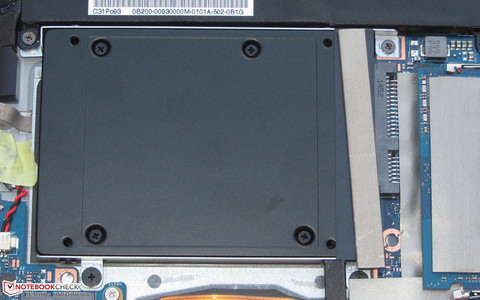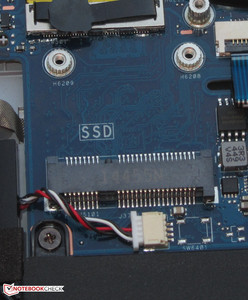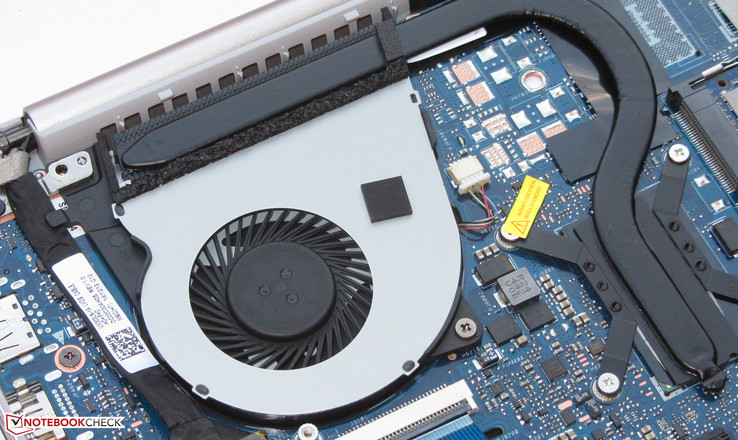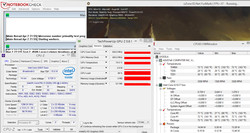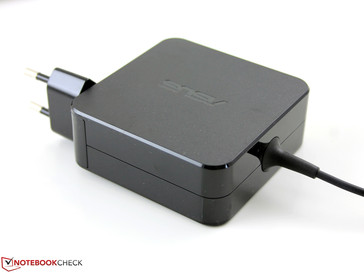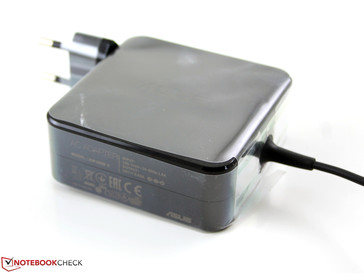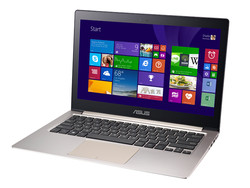Asus Zenbook UX303LA Subnotebook Review

For the original German review, see here.
The UX303LA-R4342H is yet another entry in the Asus Zenbook-lineup. We have already reviewed the family members Zenbook UX303LN-R4274H (Broadwell) and the Zenbook UX303LN-R4141H (Haswell), both of which come with a dedicated GeForce 840M graphics card. The review notebook makes use of the integrated Intel GPU instead.
Among the competition are the Dell XPS 13 and the Toshiba Portégé Z30-A. The Apple MacBook Pro Retina 13 (Early 2015) is a worthy competitor as well, but it carries a significantly higher price tag.
Since the previously reviewed models feature identical construction, we will omit the sections on the chassis, connectivity, input devices, display and speakers. For details, please refer to our review of the Zenbook UX303LN-R4141H. Please note: the pictures of the chassis in this review show the Zenbook UX303LN, but the photos depicting the inside are shots of the review notebook.
Display
The review Zenbook ships with the same exact panel type as the aforementioned brothers. Addendum 04.08.2015: since the measurements are off by more than what we normally see, we have asked Asus for a second notebook to re-evaluate the display. According to the CalMAN measurements and the observed black value, our review notebook features a contrast ratio of 410:1.
| |||||||||||||||||||||||||
Brightness Distribution: 92 %
Center on Battery: 369 cd/m²
Contrast: 527:1 (Black: 0.7 cd/m²)
ΔE ColorChecker Calman: 5.21 | ∀{0.5-29.43 Ø4.79}
ΔE Greyscale Calman: 6.7 | ∀{0.09-98 Ø5}
60.5% AdobeRGB 1998 (Argyll 1.6.3 3D)
68.2% AdobeRGB 1998 (Argyll 3D)
93.2% sRGB (Argyll 3D)
67% Display P3 (Argyll 3D)
Gamma: 2.28
CCT: 7495 K
| Asus Zenbook UX303LA-R4342H IPS 1920x1080 | Apple MacBook Pro Retina 13 inch 2015-03 IPS 2560x1600 | Dell XPS 13-9343 IPS 3200x1800 | Dell XPS 13 9343 Core i7 IPS 3200x1800 | Asus ZenBook UX305FA-FB003H IPS 3200x1600 | Toshiba Portege Z30-A-12U TN 1366x768 | Asus Zenbook UX303LN-R4274H IPS 1920x1080 | |
|---|---|---|---|---|---|---|---|
| Display | 0% | 5% | -6% | -12% | -36% | ||
| Display P3 Coverage (%) | 67 | 65.9 -2% | 72 7% | 62.6 -7% | 58.2 -13% | 41.6 -38% | |
| sRGB Coverage (%) | 93.2 | 97 4% | 96 3% | 89.8 -4% | 83.3 -11% | 61.8 -34% | |
| AdobeRGB 1998 Coverage (%) | 68.2 | 67.4 -1% | 71.6 5% | 64.2 -6% | 60.1 -12% | 43.09 -37% | |
| Screen | 32% | 47% | 18% | 7% | -33% | 15% | |
| Brightness middle (cd/m²) | 369 | 361 -2% | 367.3 0% | 232 -37% | 310 -16% | 270 -27% | 376 2% |
| Brightness (cd/m²) | 359 | 342 -5% | 372 4% | 231 -36% | 309 -14% | 265 -26% | 368 3% |
| Brightness Distribution (%) | 92 | 81 -12% | 77 -16% | 82 -11% | 90 -2% | 82 -11% | 88 -4% |
| Black Level * (cd/m²) | 0.7 | 0.361 48% | 0.178 75% | 0.25 64% | 0.75 -7% | 0.8 -14% | 0.7 -0% |
| Contrast (:1) | 527 | 1000 90% | 2063 291% | 928 76% | 413 -22% | 338 -36% | 537 2% |
| Colorchecker dE 2000 * | 5.21 | 1.82 65% | 5.92 -14% | 3.63 30% | 2.49 52% | 8.96 -72% | 3.09 41% |
| Greyscale dE 2000 * | 6.7 | 1.8 73% | 4.79 29% | 2.57 62% | 1.89 72% | 9.76 -46% | 2.4 64% |
| Gamma | 2.28 96% | 2.49 88% | 2.42 91% | 2.17 101% | 2.36 93% | 2.17 101% | 2.24 98% |
| CCT | 7495 87% | 6417 101% | 7013 93% | 6422 101% | 6573 99% | 11579 56% | 6781 96% |
| Color Space (Percent of AdobeRGB 1998) (%) | 60.5 | 61.9 2% | 63 4% | 58 -4% | 54 -11% | 39.8 -34% | |
| Colorchecker dE 2000 max. * | 3.26 | ||||||
| Color Space (Percent of sRGB) (%) | 96.9 | 96.4 | 83.1 | ||||
| Total Average (Program / Settings) | 16% /
24% | 26% /
35% | 6% /
12% | -3% /
1% | -35% /
-34% | 15% /
15% |
* ... smaller is better
Performance
The Asus Zenbook UX303LA is a long-lasting 13.3-inch subnotebook with more than adequate performance to handle the tasks encountered on a daily basis. Our review model sells for around 1000 Euro (~$1050), but Asus offers other, differently equipped versions as well. The models in the Zenbook UX303LN-series feature a dedicated GeForce 840M GPU.
Processor
The Zenbook comes equipped with a dual-core Intel Core i7-5500U (Broadwell) processor. This particular CPU features a base clock speed of 2.4 GHz, although the Turbo can overclock both cores to 2.9 GHz and a single core to 3 GHz. The Turbo is active both when the notebook is plugged in and while it is running on battery. Compared to the Haswell-predecessors, which had Core i7-4500U and Core i7-4510U processors, the Core i7-5500U is up to 15% faster according to the synthetic benchmark tests. The increase can be attributed to the slightly higher processing speed and the improvements in the Broadwell architecture.
| Octane V2 - Total Score (sort by value) | |
| Asus Zenbook UX303LA-R4342H | |
| Dell XPS 13 9343 Core i7 | |
| Acer Aspire R7-371T-52EL | |
| Asus ZenBook UX305FA-FB003H | |
| Asus Zenbook UX303LN-R4274H | |
| Peacekeeper - --- (sort by value) | |
| Asus Zenbook UX303LA-R4342H | |
| Dell XPS 13 9343 Core i7 | |
| Acer Aspire R7-371T-52EL | |
| Asus Zenbook UX303LN-R4274H | |
* ... smaller is better
System Performance
The powerful processor in combination with the solid-state disk make for a very responsive system and the results of the PCMark Benchmark tests are very good indeed. The Asus Zenbook UX305FA-FB003H clearly trails its sibling since it is equipped with a weaker processor and GPU. The model with the dedicated GeForce 840M GPU does not outperform the other notebooks, which goes to show that even a powerful GPU is no guarantee for better everyday performance.
| PCMark 7 Score | 5006 points | |
| PCMark 8 Home Score Accelerated v2 | 3087 points | |
| PCMark 8 Creative Score Accelerated v2 | 3683 points | |
| PCMark 8 Work Score Accelerated v2 | 4001 points | |
Help | ||
| PCMark 7 - Score (sort by value) | |
| Asus Zenbook UX303LA-R4342H | |
| Dell XPS 13-9343 | |
| Asus ZenBook UX305FA-FB003H | |
| Toshiba Portege Z30-A-12U | |
Storage Devices
The Zenbook comes equipped with a 2.5-inch SSD from SanDisk, which offers a capacity of 256 GB. The usable space is about 200 GB split up into an OS (95.3 GB) and a data (130 GB) partition. The rest of the space is taken up by the Windows installation itself and the recovery partition. The overall transfer rates of the drive are good, but not top-notch.
Just like its two siblings, the Zenbook UX303LA offers an open half-sized mSATA slot designed for an SSD in that particular format. The user could theoretically replace the existing SSD with an mSATA SSD and use a conventional hard drive as well. The result would be a notebook with a fast system drive, but also larger available storage. The weight would increase a little though and the battery life would drop a bit as well.
The task above is accomplished quickly and easily. Even a re-install of Windows 8.1 might not be necessary since it should be possible to clone the 2.5-inch SSD to the mSATA drive. We have illustrated this procedure when we reviewed the HP ProBook 450 G2. Although this notebook is equipped with an M.2 slot, the procedure is nonetheless identical.
GPU Performance
An Intel HD Graphics 5500 GPU handles graphics duties. The card supports DirectX 11.2 and operates at up to 950 MHz. Since the RAM runs in dual-channel mode, our Zenbook did better when running the 3D Mark benchmarks test than competing notebooks equipped with only one RAM module and the RAM operating in single-channel mode.
| 3DMark 11 Performance | 1159 points | |
| 3DMark Ice Storm Standard Score | 52880 points | |
| 3DMark Cloud Gate Standard Score | 5342 points | |
| 3DMark Fire Strike Score | 725 points | |
Help | ||
Gaming Performance
The combination of the Core i7 processor with the HD Graphics 5500 GPU makes occasional gaming possible, provided that the user selects a low resolution and low to medium quality. Less power-hungry games allow for higher graphics settings as well. Games also profit from the RAM running in dual-channel mode: the frame rates are higher by about 5% to 40% compared to notebooks with their RAM running in single-channel mode. The sibling Zenbook UX303LN, which is equipped with a GeForce 840M GPU, offers significantly better gaming performance. Models in that series start around 1000 Euro ($1050).
| low | med. | high | ultra | |
|---|---|---|---|---|
| Tomb Raider (2013) | 55.8 | 28.5 | 18.6 | 8.9 |
| Thief (2014) | 17.1 | 11.3 | 9.2 | 4.6 |
| Battlefield Hardline (2015) | 27.7 | 19.7 | 8.1 | 4.9 |
Emissions
System Noise
The Zenbook never gets very hot and during idle, the fan frequently does not spin at all, which makes the subnotebook more or less inaudible. Even under load, the fan noise is subdued and we measured a maximum of only 36.6 dB(A) during the stress test. The reason: both the CPU and the GPU are subjected to throttling during major system stress.
Noise level
| Idle |
| 30.2 / 30.8 / 31.6 dB(A) |
| Load |
| 36.4 / 36.6 dB(A) |
 | ||
30 dB silent 40 dB(A) audible 50 dB(A) loud |
||
min: | ||
| Asus Zenbook UX303LA-R4342H 5500/5500U | Apple MacBook Pro Retina 13 inch 2015-03 6100/5257U | Dell XPS 13-9343 5500/5200U | Dell XPS 13 9343 Core i7 5500/5500U | Toshiba Portege Z30-A-12U 4400/4500U | Asus Zenbook UX303LN-R4274H 840M/5500U | |
|---|---|---|---|---|---|---|
| Noise | -5% | -4% | -7% | -6% | -2% | |
| Idle Minimum * (dB) | 30.2 | 29 4% | 30.2 -0% | 29.6 2% | 29.6 2% | 31 -3% |
| Idle Average * (dB) | 30.8 | 29 6% | 30.3 2% | 29.6 4% | 29.6 4% | 31 -1% |
| Idle Maximum * (dB) | 31.6 | 29 8% | 30.4 4% | 33.2 -5% | 31.6 -0% | 31 2% |
| Load Average * (dB) | 36.4 | 42.5 -17% | 34.4 5% | 43.2 -19% | 41.5 -14% | 36.6 -1% |
| Load Maximum * (dB) | 36.6 | 45.6 -25% | 48 -31% | 43.2 -18% | 44.2 -21% | 39.3 -7% |
* ... smaller is better
Temperature
The Zenbook handles the stress test (Prime95 and FurMark in parallel for at least one hour) in identical fashion no matter if it is plugged in or running on battery power. While the processor cores fluctuate between 1.3 - 1.4 GHz, the GPU hovers around 650 - 700 MHz. The chassis does not get very warm during the test and only exceeds 40 degrees Celsius (104 Fahrenheit) slightly in one spot.
(±) The maximum temperature on the upper side is 41.1 °C / 106 F, compared to the average of 35.9 °C / 97 F, ranging from 21.4 to 59 °C for the class Subnotebook.
(+) The bottom heats up to a maximum of 37.5 °C / 100 F, compared to the average of 39.3 °C / 103 F
(+) In idle usage, the average temperature for the upper side is 24.8 °C / 77 F, compared to the device average of 30.8 °C / 87 F.
(+) The palmrests and touchpad are cooler than skin temperature with a maximum of 31.2 °C / 88.2 F and are therefore cool to the touch.
(-) The average temperature of the palmrest area of similar devices was 28.2 °C / 82.8 F (-3 °C / -5.4 F).
| Asus Zenbook UX303LA-R4342H 5500/5500U | Apple MacBook Pro Retina 13 inch 2015-03 6100/5257U | Dell XPS 13-9343 5500/5200U | Dell XPS 13 9343 Core i7 5500/5500U | Asus ZenBook UX305FA-FB003H 5300/5Y10 | Toshiba Portege Z30-A-12U 4400/4500U | Asus Zenbook UX303LN-R4274H 840M/5500U | |
|---|---|---|---|---|---|---|---|
| Heat | -10% | -13% | -1% | -5% | -2% | -10% | |
| Maximum Upper Side * (°C) | 41.1 | 45.1 -10% | 40.6 1% | 43.4 -6% | 43.1 -5% | 40.8 1% | 47.1 -15% |
| Maximum Bottom * (°C) | 37.5 | 39.6 -6% | 41.2 -10% | 37 1% | 41.2 -10% | 36.2 3% | 43.4 -16% |
| Idle Upper Side * (°C) | 25.3 | 28.5 -13% | 31.2 -23% | 25.9 -2% | 26.3 -4% | 27.7 -9% | 27.1 -7% |
| Idle Bottom * (°C) | 25.7 | 28.3 -10% | 30.6 -19% | 25.1 2% | 26.2 -2% | 26.2 -2% | 26.3 -2% |
* ... smaller is better
Energy Management
Power Consumption
Nothing is out of the ordinary as far as the power consumption is concerned. When idle, the subnotebook consumes less than 10 watts; during the stress test, we recorded a maximum of 30.5 watts. The power consumption could theoretically be higher, but both the CPU and the GPU are throttled during the stress test. The power adapter can supply up to 65 watts and could handle higher loads.
| Off / Standby | |
| Idle | |
| Load |
|
Key:
min: | |
| Asus Zenbook UX303LA-R4342H 5500/5500U | Apple MacBook Pro Retina 13 inch 2015-03 6100/5257U | Dell XPS 13 9343 Core i7 5500/5500U | Asus ZenBook UX305FA-FB003H 5300/5Y10 | Toshiba Portege Z30-A-12U 4400/4500U | Asus Zenbook UX303LN-R4274H 840M/5500U | |
|---|---|---|---|---|---|---|
| Power Consumption | -40% | -48% | -3% | 8% | -20% | |
| Idle Minimum * (Watt) | 2.6 | 2.8 -8% | 6.6 -154% | 3.1 -19% | 3.5 -35% | 2.6 -0% |
| Idle Average * (Watt) | 6.2 | 7.8 -26% | 9.3 -50% | 7.5 -21% | 4.1 34% | 6.8 -10% |
| Idle Maximum * (Watt) | 9.2 | 8.1 12% | 11 -20% | 8.6 7% | 7.1 23% | 7.9 14% |
| Load Average * (Watt) | 30.4 | 52.4 -72% | 32.2 -6% | 25.2 17% | 27.3 10% | 40.1 -32% |
| Load Maximum * (Watt) | 30.5 | 62.8 -106% | 33.2 -9% | 30.6 -0% | 27.6 10% | 52.1 -71% |
* ... smaller is better
Battery Life
In idle mode, the Zenbook lasted 19 hours and 7 minutes, which falls between the MacBook Pro Retina 13 (28 hours 10 minutes) and the Dell XPS 13 (15 hours 12 minutes). Here, we use the Battery Eater Reader’s Test with the display set to the lowest brightness, the power-saver profile active, and all wireless modules turned off. Under load, the Zenbook needed to be plugged in again after 1 hour and 55 minutes - once again a run time in the middle between the MacBook Pro (1 hour 34 minutes) and the XPS 13 (2 hours 20 minutes).
During the more relevant WLAN test, the ASUS notebook shut down after 8 hours and 27 minutes, which is a result that trails both the MacBook Pro (8 hours 59 minutes) and the Dell XPS 13 (9 hours 41 minutes). Here we use the balanced profile and set the display brightness to about 150 nits; a script then visits a different web page every 40 seconds. To check the run time during video playback, we loop the clip Big Buck Bunny (H.264 codec, 1920x1080 pixels). Here we once again disable the wireless modules and set the display brightness to around 150 nits. The Zenbook kept going for 8 hours and 3 minutes during this test; the MacBook Pro lasted longer at 9 hours and 41 minutes.
The Zenbook and the Dell XPS 13 are pretty even as far as their respective battery life is concerned. It is not surprising that the MacBook Pro outperforms them both, as its battery capacity is substantially higher (Asus: 50 Wh, Dell: 52 Wh, Apple: 74.9 Wh).
| Asus Zenbook UX303LA-R4342H 5500/5500U | Apple MacBook Pro Retina 13 inch 2015-03 6100/5257U | Dell XPS 13-9343 5500/5200U | Dell XPS 13 9343 Core i7 5500/5500U | Asus ZenBook UX305FA-FB003H 5300/5Y10 | Toshiba Portege Z30-A-12U 4400/4500U | Asus Zenbook UX303LN-R4274H 840M/5500U | |
|---|---|---|---|---|---|---|---|
| Battery runtime | 15% | 1% | 6% | 13% | 4% | ||
| Reader / Idle (h) | 19.1 | 28.2 48% | 15.2 -20% | 13 -32% | 19.9 4% | ||
| H.264 (h) | 8.1 | 9.7 20% | 6.6 -19% | ||||
| WiFi v1.3 (h) | 8.5 | 9 6% | 8.8 4% | ||||
| Load (h) | 1.9 | 1.6 -16% | 2.3 21% | 3.2 68% | 2.3 21% | ||
| WiFi (h) | 9.7 | 7 | 6.8 | 7.6 |
Pros
Cons
Verdict
The Asus Zenbook UX303LA-R4342H is a compact and mobile 13.3-inch subnotebook. For all intents and purposes, we could just reiterate our verdict with which we concluded the review of the UX303LN-sibling. The notebook offers enough processing power for everyday tasks, is very quiet and does not get very warm, either. Good input devices and a long battery life are added bonuses. The solid-state disk guarantees speedy performance and the removable bottom cover makes maintenance tasks easy.
The matte IPS display is somewhat disappointing. The brightness is quite good, but the contrast of the Zenbook is simply not acceptable for the given price point.
Asus Zenbook UX303LA-R4342H
- 05/18/2015 v4 (old)
Sascha Mölck




